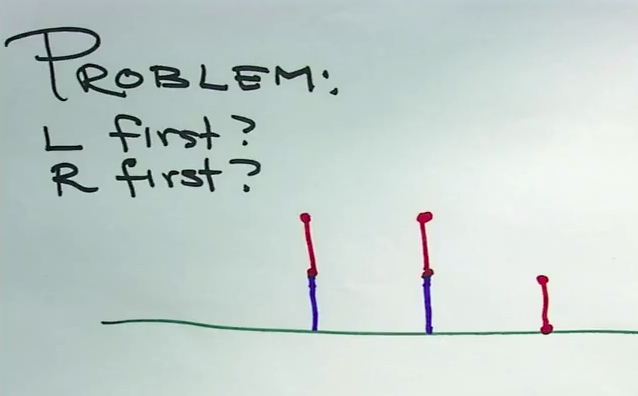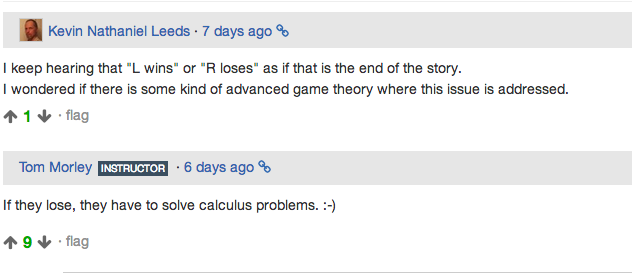One of the most engaging educational experiences I’ve had so far, not just on Coursera but in general, just ended: Tom Morley’s Games without Chance: Combinatorial Game Theory. If you’re like me two months ago, you now probably wonder what a mathematical game is. So, let’s start in medias res by showing you one of the mathematical games we’ve studied. Here’s a position of Hackenbush:
The players, called “Left” and “Right” respectively, move in turns. Left cuts the blue stalks, and Right the red ones. Cut stalks are removed from the game. In addition, any other stalk that has no connection to the ground anymore after a move is removed as well. The first player to not have a move left loses the game.
The entire course can be easily described just based on this one game. Of course, you can just look at one single Hackenbush tree and enumerate all possibilities, trying to mechanically figure out who has to win or lose given best play. There are four possible outcomes. The winner is either Left, Right, the first player to move, or the second player to move. This works well with a small tree, but if you start with a complicated enough tree, add more trees to the game, or even add different kinds of games, this procedure quickly becomes impractical. So what else can you do?
Well, you could represent the trees as numbers and figure out the result of the game based on that, and you can also simplify games to positions that are easier to reason about. Of course, if it’s possible to represent a game as a number, the simplification happens numerically. On the other hand, if the game is represented as a position, you can translate it into a simplified game position, e.g. a complex Hackenbush tree into one that has the same outcome but is easier to reason about.
Those were the main points of the course. Of course, the occasional proof was thrown in as well. Further, we studied more than just Hackenbush. Above, I alluded to other games, which you could add to a given Hackenbush formation. Those were Nim, Toads and Frogs, Cut Cake, and a few others. Feel free to look them up. However, you’ll notice that they are interesting due to their mathematical properties, but that they aren’t necessarily the kind of game you’d play with your friends to pass the time. After all, the essence of mathematical games is to study rules, strategies, and outcomes using the tools of mathematics, and only incidentally to play them.
There were no prerequisites for this course, but it was “highly recommended that students have taken rigorous college level Mathematics courses”. If you’ve been exposed to college-level mathematics, particularly discrete mathematics, you should find the course very accessible. Without this background, though, you may find it difficult to make the conceptual jump to abstract reasoning. I found the material quite easy to follow, but I’ll refrain from calling Games without Chance an easy course. In the forums there were complaints that the course didn’t “make any sense”, but such statements were rather rare, presumably because the crowd seemed highly self-selecting.
The course was small, and it felt small. In fact, for the first time when taking a Coursera course I thought that skimming the forums was worth my time. Tom Morley himself contributed quite a bit, too, often with his delightful and quirky sense of humor, for instance in this exchange:
Lastly, let me remark that the course was well-organized. The people at Georgia Tech seem to have put a lot of thought into it. While most courses on Coursera greet you on the announcement page, and from there on let you explore videos, quizzes, extra problems and so on, Games without Chance had, in addition, tabs that summarized the relevant content for each of the seven weeks. From one page you could access a summary of the relevant part of the syllabus, slides, videos, quizzes, and extra problems. At the very end they sneaked in a weekly survey asking for feedback regarding how you perceived the difficulty and how much time you’ve spent on the problems.
Overall, I found that Games without Chance was well worth my time. I’d highly recommend it to anyone who enjoys abstract reasoning. If you love puzzling over problems in, say, graph theory, or enjoy formal logic, then this is probably a course you might want to consider taking when (if?) it is offered again in the future.


